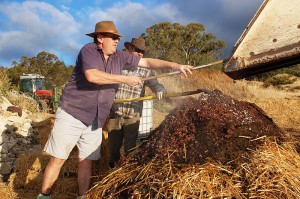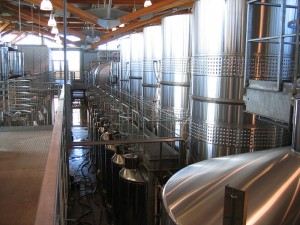The following is a guest post written by Anty Fung. Please read Anty’s full bio at the end of this post!
A Brief History of Biodymanics
Biodynamics is “the basic new way of thinking about the relationship between earth and soil to the formative forces of etheric, astral and ego activity of nature”.[1] Part of the Anthroposophist movement founded by Rudolf Steiner in 1924, biodynamic agriculture was first developed by Maria Thun and her team in Germany and Holland, and since then has gained increasing support from winemakers around the world.
In 1928, Demeter was established as a program certifying the practice of biodynamic agriculture. The cardinal rule of biodynamic agriculture is to respect the “cosmic creative and shaping forces” of nature and celestial bodies

Biodynamic Composting. Photo credit: By Mark Smith [CC-BY-2.0 (http://creativecommons.org/licenses/by/2.0)], via Wikimedia Commons
This post, however, sets out to deal with biodynamic vinification (a.k.a. biodynamic winemaking), an area highly relevant to biodynamic viticulture and yet it has only been formalized in June 2008 as an essential part of “Standards for Demeter/ Biodynamic Wine”.[2] Arguably, the standards required for fulfillment fell short of the expectations of France and Italy, both of which have their own disciplinary bodies to regulate and monitor whether biodynamic standards are strictly conformed by Demeter certified wineries in their countries. Nonetheless, the 2008 standards laid down a few rules for Demeter certified wineries on alcoholic fermentation, which were to be enforced from the 2008 vintage onward. These standards include the following:
- Fermentation technique: Heating to speed up fermentation is permitted. Pasteurization is disallowed.
- Choice of yeast: Indigenous yeasts, pied de cuve (Demeter or organic), Demeter or organic yeast, GMO free commercial yeast are allowed.
- Yeast nutrients: Demeter/ organic yeast hulls are allowed. All other forms of nutrients require approval from respective organizations.[3]
Experiment
In 2011, a group of Italian researchers looked deeper into the chemistry behind biodynamic winemaking, specifically examining the evolution of indigenous yeasts during different spontaneous biodynamic alcoholic fermentation processes.
For that study, Trebbiano grapes grown along principles of biodynamic agriculture were picked from an Italian winery in Abruzzo, harvested by hand as is required by Demeter standards, and randomly placed into five different treatments after soft crushing.
The five different treatments were performed during this study: 1) “Low Nitrogen vinification”; 2) “Nitrogen vinification”; 3)“Nitrogen-thiamin vinification”; 4) “Nitrogen-oxygen vinification”; and 5) “Nitrogen-pied de cuvee vinification”.
The team monitored the rate of decrease in must density to gauge the rate of alcoholic fermentation. The level of promptly assimilable nitrogen (PAN) was also measured, since the higher the level of PAN, the lower the risk of having a stuck fermentation. According to Bisson and Butzke, the level of PAN is crucial for yeast growth. The production of aromatic compounds, notably esters, is also largely dependent on the level of PAN available for assimilation by yeasts.[4]
Results

Photo credit: I, Tomas er [GFDL (http://www.gnu.org/copyleft/fdl.html), CC-BY-SA-3.0 (http://creativecommons.org/licenses/by-sa/3.0/) or FAL], via Wikimedia Commons
There is a synergy between nitrogen and oxygen[5], meaning that given an aerobic alcoholic fermentation environment, cellular permeability is maintained thus ensuring ease of nitrogen absorption whilst sugars are continuously utilized and converted to alcohol. The “Nitrogen-pied de cuvee vinification” treatment maintained a good rate of must density since the existence of Pied de cuvee gave the fermenting must time and opportunities to adapt to the process conditions. Pied de cuvee involves the cultivation of indigenous yeasts on skins of early harvested grapes and allow the same yeasts inoculate the fermentation.
As fermentation rates started to vary among different treatments from Day 4 onward, diammonium phosphate and diammonium sulphate (1:1) salts were added in limited quantity to integrate nitrogen availability in grape must. Note: the use of diammonium phosphate is strictly prohibited according to the 2008 Demeter standards. Nonetheless, the addition revived alcoholic fermentation and sugar consumption continued for all treatments except the “low-nitrogen vinification” treatment.
The number of days elapsed for density loss to reach 0% ranged from 14 to 16 days for the other five treatments, whilst that for treatment no. 1 lasted 11 days only. The results of this first part of the experiment illustrate the importance of nitrogen integration in grape must during biodynamic vinification.
The second part of the experiment looked at the level of lactic acid bacteria and acetic acid bacteria which can be found at the end of alcoholic fermentation. The levels of these two bacteria are generally predictable when one uses commercial starter yeasts, which produce low levels of sulphur dioxide. Uncertainty kicks in when indigenous yeasts are used, as the level of sulphur dioxide produced varies. This is important because the higher the level of sulphur dioxide, the lower the rate of malolactic fermentation due to suppressed lactic acid bacterial activity. Given a low pH, this process may be completely halted despite possible intentions of the winemaker to soften acidity.
The existence of acetic acid bacteria correlates with the level of volatile acidity in a wine. The level of sulphur dioxide and acetic acid bacteria are in negative correlation. Among all five treatments, the “nitrogen-thiamin vinification” treatment recorded the highest level of lactic acid and acetic acid bacteria. On the other end, the “low-nitrogen vinification” treatment recorded the lowest levels of lactic acid and acetic acid bacteria. The researchers attributed this result to this particular treatment having the highest concentration of non-commercial starter yeasts (non Saccharomyces), which generated considerable amounts of sulphur dioxide.
Conclusion
A rather obvious conclusion drawn from this experiment on indigenous yeast activity under different biodynamic vinification mechanisms is that the role of nitrogen is essential to ensure a smooth and complete
fermentation of grape must. The synergy between nitrogen and oxygen may reduce the reliance on nitrogen addition during alcoholic fermentation.
Which Biodynamic Vinification Method is Best?
To attain a rounder malolactic fermentation-driven wine style using biodynamic vinification, the “nitrogen-oxygen” and “nitrogen-thiamin” vinification processes would be ideal. The researchers identify the results of “nitrogen-pied de cuvee” vinification process as the most interesting one due to the surprisingly low level of acetic acid detected in the results. Finally, the “nitrogen vinfication” processes would come in handy for winemakers aiming for stable, aromatic wines with refreshing acidity. Depending upon which style of wine the winemaker ultimately aims to produce, any one of these biodymanic vinification processes would work.
Sources:
- Cusack, C. M., & Norman, A. (2012). Handbook of new religions and cultural production. Leiden, Brill. Page 125
- P. Vastola, A. (2008) Biodynamic Wine: An economic and ethic choice. Università degli Studi della Basilicata, DITEC.
- Demeter International e.V. (2008) Standards for Demeter/ Biodynamic Wine. [online] Available at: http://organicstandard.com.ua/files/standards/en/demeter/st_wine_e08.pdf [Accessed: 15 Nov 2012].
- Daniel GRANES, Edouard MEDINA, Lucile BLATEYRON, Céline ROMERO, Eric BRU, Christophe ROUX, Caroline BONNEFOND, Agnès PIPERNO, Myriam ROUANET, Thomas OUI (2007) ICV Harvest Flash Info. ICV Montpellier, France [online] Available at: http://www.icv.fr/documents/Bibliotheque/Biblio_flashs_infos/Flash_infos_22_Nitrogen_nutrition_yeasts.pdf [Accessed: 15 Nov 2012]
- R. Guzzon, G. Widmann, L. Settanni, M. Malacarne, N. Francesca, R. Larcher (2011) Evolution of Yeast Populations during Different Biodynamic Winemaking Processes. South African Journal of Enology and Viticulture, Vol. 32, No. 2. Page 242-250
Anty Fung currently works at AsianPalate.com where she contributes regularly to the food and wine trend sections. She has completed her WSET Advanced Certificate and is now pursuing WSET Level 4 Diploma. She bases in Hong Kong where she enjoys looking for hidden food joints and local delis to try out unconventional pairings whenever she is allowed to bring her own bottles (and glasses!). You can reach her at antyfung@gmail.com or via Facebook (Anty Fung).


4 comments for “The Importance of Nitrogen Availability in Grape Must During Biodynamic Vinification”